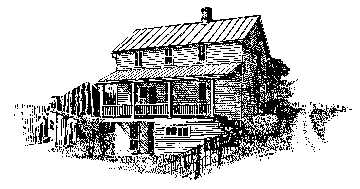Heritage Landmarks: Robert Strawbridge House, New Windsor
A Traveler’s Guide to the Most Sacred Places in The United Methodist Church
» View the original article
» Download the PDF of all United Methodist Heritage Landmarks
 Robert Strawbridge ( ? -1781) emigrated from Ireland to Frederick County, Maryland sometime between 1760 and 1766. A Methodist preacher in Ireland, he began preaching in Maryland soon after his arrival, making him the pioneer of Methodism on the American continent.
Robert Strawbridge ( ? -1781) emigrated from Ireland to Frederick County, Maryland sometime between 1760 and 1766. A Methodist preacher in Ireland, he began preaching in Maryland soon after his arrival, making him the pioneer of Methodism on the American continent.
He preached in his log cabin home and began organizing Methodist societies as early as 1763 or 1764. The first class met in his home and soon a second met at a nearby home. John Evans (1734-1827), one of Strawbridge's converts, led the first class from 1768-1804. These were perhaps the earliest Methodist organizations in American history. During these early years, Strawbridge also built log meeting houses at Sam's Creek and Bush near Aberdeen.
Strawbridge soon began itinerating in Maryland, Pennsylvania, and Virginia, often preaching the first Methodist sermons heard in a settlement. He established a number of societies, prompted the construction of several Methodist chapels, possibly including the Old Stone Church in Leesburg, Virginia. He was tremendously popular and had a major influence on many young preachers.
Strawbridge, who probably was never ordained, nevertheless regularly administered the sacraments. At the first conference of Methodist preachers in America (1773), this practice was condemned, although an exception was made for Strawbridge, who was allowed to continue it under Asbury's direction. Francis Asbury
Asbury recorded his frustration in his journal entry for June 24, 1774: "[O]ne of these letters informed me that Mr. Strawbridge was very officious in
The Strawbridge house passed into other hands and was forgotten until 1915, when a Maryland Methodist historian, Mrs. Arthur Bibbins, identified it. The Strawbridge Shrine Association was organized in 1934 and acquired the property in 1973.
Points of interest at this Heritage Landmark: Strawbridge's log cabin home was later enlarged and clapboarded; it is this home that visitors can tour.
Special events: None as of this writing.
Area attractions: New Windsor is near the historical and cultural attractions of Gettysburg, PA; Baltimore, MD; and Washington, DC. Other Heritage Landmarks in this annual conference are Old Otterbein Church, the Cokesbury College Site, and the Lovely Lane Meetinghouse Site. Visitors will also want to tour the Lovely Lane Museum (see address below). There is also an international gift ship at the Brethren Service Center in New Windsor.
To visit: The buildings may be viewed at any time; appointments for guided tours may be made by contacting the Tour Coordinator at 410-635-2600 or
. The property, a
Location: Strawbridge House is within the boundaries of the Baltimore-Washington Annual Conference, in Carroll County, Maryland, about 40 miles northwest of Baltimore.
Food and lodging: Nearby food and lodging
Directions: From the north: travel south on state
From the south: from Interstate 70, travel north for 11 miles on state route 27, then left for four miles on state route 407 and right for one mile to Wakefield Valley Rd. Turn right and go one mile to Wilt Rd., then right for 300 feet to Strawbridge Lane; turn right and go 500 feet to the Heritage Landmark.
Website: http://www.strawbridgeshrine.org
For further information, contact: John Strawbridge, Communications Director, Strawbridge Shrine Association, c/o 2200 St. Paul Street, Baltimore, MD 21218-5805; 410-635-2600; or .
To learn more about United Methodist church history in this area:
- Lovely Lane Museum, 2200 St. Paul St., Baltimore, MD 21218; 410-889-4458.
- Gordon Pratt Baker, Those Incredible Methodists: A History of the Baltimore Conference of The United Methodist Church (Baltimore: Baltimore Conference Commission on Archives and History, 1972).
- Charles Miller and William Raker, The Histories of
the Pennsylvania and Central Pennsylvania Conferences of the Evangelical United Brethren Church (York, PA: by the authors, 1968).
